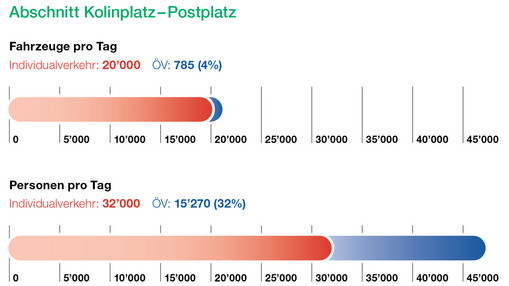The ZVB buses are also sometimes stuck in traffic jams.
This is an important issue. Punctual, reliable public transport is extremely important. Passengers should reach their destination on time and connections must be guaranteed. If the ZVB is stuck in traffic jams, we cannot fulfil this task. However, customers must be able to rely on public transport so that it can make its contribution to overall mobility and provide its benefits. It therefore needs certain framework conditions.
What framework conditions does the ZVB need?
There are various solutions to ensure timetable stability. Prioritisation at traffic lights is a simple measure. A separate bus lane for sections with high traffic volumes is a more far-reaching solution, although this does not necessarily have to be structural, but can also be achieved operationally by prioritisation. Riding in the flowing mass of cars can be a solution if the appropriate prioritisation is in place at junctions and stops. It should also be considered whether all modes of transport need to travel on the same road. If they all travel on the same axis, there must be a correspondingly large road cross-section. Separating high-speed and low-speed modes of transport makes traffic flow more smoothly and therefore more effectively. Public transport also benefits from this, as it can run more reliably. These are just a few examples. All our endeavours are always aimed at safe, reliable and high-quality public transport that provides many benefits.
What do you mean by quality in public transport?
In addition to punctuality and timetable stability - which is becoming increasingly difficult to maintain - it's about offering passengers the most pleasant journey possible. I'm thinking here of obstacle-free bus stops, pleasant waiting areas, information systems of a high standard and, fundamentally, good public transport accessibility. Of course, I consider it desirable for public transport to run on vehicles powered by renewable energy.
However, quality also means that new forms of multimodal mobility are offered, such as the combination of public transport and bike sharing or on-demand services. New forms will certainly be added and development is progressing rapidly. The digital and spatial networking of the various existing and new forms is important and must be orchestrated. We also see this as a contribution by the ZVB. After all, the various measures will increase Zug's attractiveness as a location.



